25 Best Museums in Tbilisi for Culture, History & Art
Museums in Tbilisi offer a clear and engaging way to understand Georgia’s story — from ancient civilizations and ethnographic traditions to Soviet-era history and modern cultural shifts. Whether you’re curious about archaeology, winemaking, folklore, or the city’s artistic heritage, these museums add depth to any visit.
Whenever I want a deeper look at my own country or simply need a quiet escape on a cold or rainy day, I find myself stepping into one of Tbilisi’s small or big museums. They’re easy to pair with the main sights and activities around the city, so you can blend them into your plans without much effort.

In this guide, you’ll find some of the best museums in Tbilisi, organized by theme, covering history, culture, literature, and a few unusual and quirky spots worth checking out. Each entry includes opening hours, ticket prices, and a link for additional information if available.
At the end of the post, you’ll also find a short FAQ section covering practical details such as opening hours, free-entry options, and what to expect when visiting Tbilisi museums.
My favorite museums in Tbilisi – quick list
- Archaeological Treasury & Soviet Occupation Hall at Georgian National Museum – For its breathtaking ancient jewelry crafted centuries ago and the powerful, sobering look at Georgia’s 70 years under Soviet rule.
- Tbilisi State Academy of Arts Museum – For the mirror-mosaic halls — one of the most beautiful and unexpected interiors in the city.
- Writers House of Georgia – For its stunning Art Nouveau interiors and a rare chance to see how Tbilisi’s bourgeoisie lived in the early 20th century.
- Merab Kostava Memorial House-Museum – For understanding Tbilisi’s recent history and the people who led Georgia’s fight against the USSR.
- Kote and Soso Tsereteli Memorial House-Museum – For a deeper look into life under Soviet rule, the struggle for personal freedom, and the tragic airplane hijacking case of the 1980s.
- Tbilisi History Museum – For tracing how the city developed over the centuries, from its Silk Road past to modern times.
- Tea Museum Shop – For its tiny but charming display of vintage tea items and a peek into the rise, decline, and revival of Georgian tea production.
- Art Palace – For its incredible collection of theater, cinema, and music heritage — and for the stunning furniture, costumes, and china.
- Elene Akhvlediani House Museum – For her beautiful landscape paintings of Tbilisi, Georgian towns, and European cities — warm, nostalgic, and instantly recognizable.
Map of Tbilisi museums
Use this Google Maps list to follow all the locations from this Tbilisi museums guide. Save it to your phone and download the area offline so you can move around the city smoothly, even without data.
History & culture museums
Georgian National Museum (Simon Janashia Museum of Georgia)
Located on Rustaveli Avenue, the Simon Janashia Museum of Georgia is one of the most important history museums in the city. It has several permanent exhibitions, including the Soviet Occupation Hall and Archaeological Treasury, and one ticket gives you access to all rooms. Here’s what you’ll find inside.
Stone Age Georgia
The first room explores human life on the territory of present-day Georgia. Because of its location, the Caucasus was a crossroads of cultures, and early humans lived here for nearly 2 million years.

Dozens of skulls discovered in archaeological excavations immediately catch the eye, alongside pieces found in Africa and Asia. The exhibition walks you through human evolution and regional fauna.
You’ll also see the famous Zezva and Mzia busts from the Dmanisi archaeological site near Bolnisi city — considered the earliest humans in Eurasia and one of the most significant discoveries in Georgia.
Caucasus Biodiversity
From there, you can step into a room showcasing the region’s biodiversity through botanical, geological, and zoological collections. Some species on display are extinct or endangered.

The hall features minerals and rocks from around the Caucasus, along with stuffed birds, mammals, insects, reptiles, and fish. Kids usually enjoy the mammal display with a digital screen that plays different animal sounds.
A large printed Caucasus Biodiversity Map, created together with National Geographic Georgia, helps visualize which species are endemic to each area.
Archaeological Treasury
This is my favorite room in the museum, and even if you don’t plan to explore everything, make time for this one. It displays extraordinary examples of ancient Georgian goldsmithing, discovered during archaeological excavations.

The items date from the 3rd century BCE to the 4th century CE, largely from burial grounds in Kakheti, Kartli, and Trialeti. You’ll see intricate jewelry from the Colchis Kingdom — bracelets, wreaths, rings, and necklaces crafted with incredible detail.
Numismatic Treasury
Next door is a compact room with coins that circulated on Georgian territory from the 6th century BCE to 1834.

The collection starts with primitive money such as large bronze circles and Kauri shells from the Indian Ocean. With around 3,500 coins on display, you can see Colchian tetri, coins from the reigns of Alexander the Great and Roman emperors, and Sassanian dynasty coins.
Zurab Kobiashvili Unknown Collections
This room showcases the private collection of General Zurab Kobiashvili, who traveled extensively through Europe and Asia during his military career. He assembled a notable selection of Oriental Art and weaponry from the 16th to 19th centuries.
The display includes nearly 200 weapons used across Georgia, Russia, Europe, the Middle East, China, Japan, Mongolia, and India, as well as statues, household items, ceramics, and traditional clothing.
Soviet Occupation Hall
Located on the top floor, this exhibition is another room worth your attention, documenting 70 years of the Soviet occupation of Georgia from 1921 to 1991.

Displays are arranged chronologically, with photos, documents, and videos that show the events and victims of Soviet repression. In the center of the room, a typical Soviet officer’s desk is set with documents and personal items, offering a slight peek into how that era looked and operated.
One of the most striking objects is a wooden train carriage used to execute participants of the 1924 national uprising.
- Opening hours: Tue-Sun from 10 am to 6 pm. Closed on Mondays
- Entrance fee: adults – 15 GEL for Georgian citizens; 30 GEL for foreigners
Plan Your Trip to Georgia Like A Pro
Open Air Museum of Ethnography
Set on the hills above Vake Park, the Giorgi Chitaia Open Air Museum of Ethnography is the easiest way to see Georgia’s regional architecture and folk traditions without leaving Tbilisi.

Founded in 1966 by ethnographer Giorgi Chitaia, the museum spans more than 50 hectares and comprises 11 sectors, with around 70 traditional houses brought from different parts of the country.
You’ll see everything from a Svan defensive tower to a Meskhetian darbazuli house from Samtskhe–Javakheti, each representing a distinct regional building style. Inside, the homes are furnished with original household tools, textiles, and everyday items that show how people lived across various regions.
The grounds also host the annual Art-Gene folk festival in summer and often become part of Tbilisoba celebrations in autumn.
How to get there
There’s no direct public transport to the museum, so the easiest option is taking a Bolt taxi, which usually costs around 10–13 GEL from the city center.
If you prefer walking, you can hike uphill from Vake Park in about 40–50 minutes. Another option is to ride the Soviet-era cable car from Vake Park to Turtle Lake (Kus Tba), then walk downhill for about 20 minutes. You’ll find more details in my Tbilisi public transport guide.
- Opening hours: Tue-Sun from 10 am to 6 pm. Closed on Mondays
- Entrance fee: adults – 8 GEL for Georgian citizens; 25 GEL for foreigners
Tbilisi History Museum
Set inside a beautifully restored caravanserai next to Sioni Cathedral in the Old Town, the Tbilisi History Museum displays more than 50,000 artifacts that trace the story of the capital and its role along the old Silk Road trading route.

It’s one of the most insightful Tbilisi museums if you want to understand how the city has grown and changed over the years. The exhibits combine ancient ethnographic and archaeological pieces with archival photographs, scale models of historical houses and workshops, and even miniature versions of the trams that once ran through Tbilisi.
You’ll also see traditional clothing and furniture once used by noble families, as well as metal tins of sweets and candies produced in local factories.
- Opening hours: Tue-Sun from 10 am to 6 pm. Closed on Mondays
- Entrance fee: adults – 10 GEL for Georgian citizens; 15 GEL for foreigners
Merab Kostava Memorial House-Museum
The newly renovated Merab Kostava Memorial House-Museum, located just above Rustaveli Metro, is one of the most meaningful additions to the city’s museum scene.
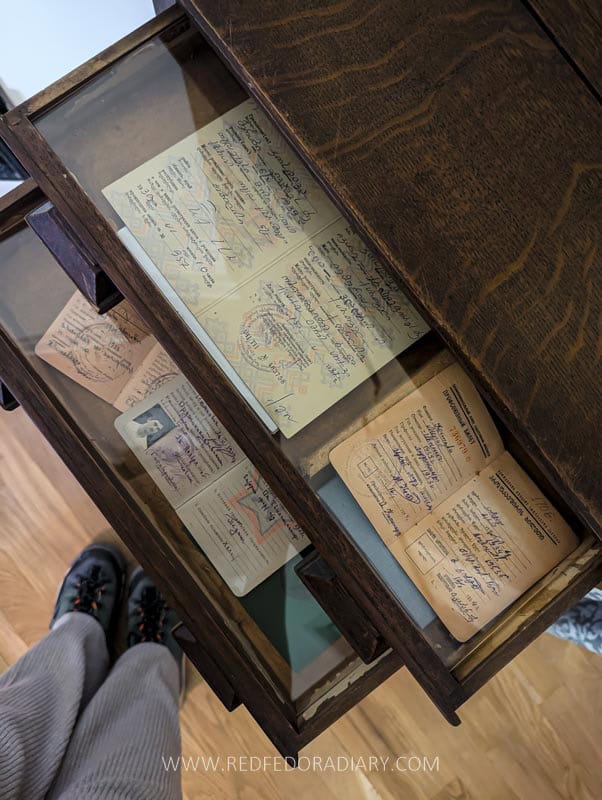
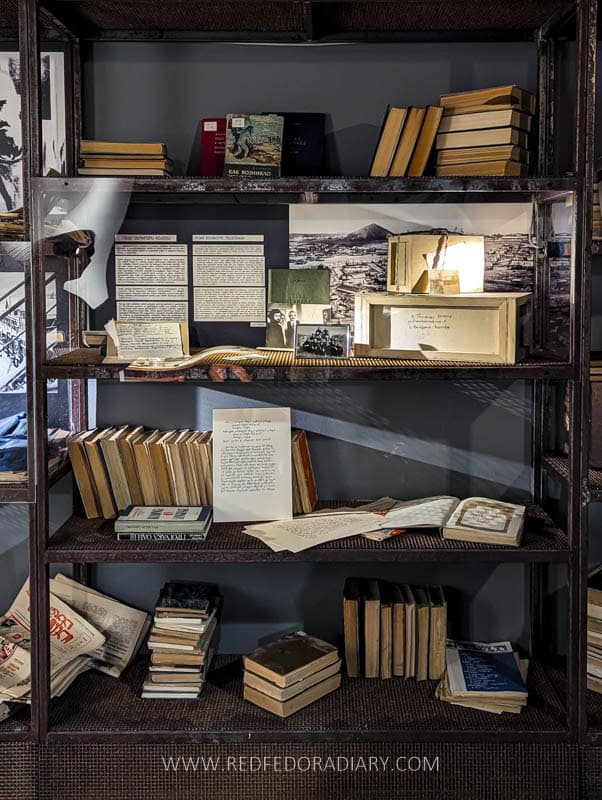
Merab Kostava (1939–1989) was a poet, musician, musicologist, and one of the leading dissidents of the Soviet era. Alongside Zviad Gamsakhurdia (later the first president of Independent Georgia), he became a central figure in Georgia’s peaceful national-liberation movement during the late 1980s.
The three-floor museum is exceptionally well laid out, with English signage, digital screens, and detailed explanations that guide you through Kostava’s life, activism, and the broader political climate of the time.
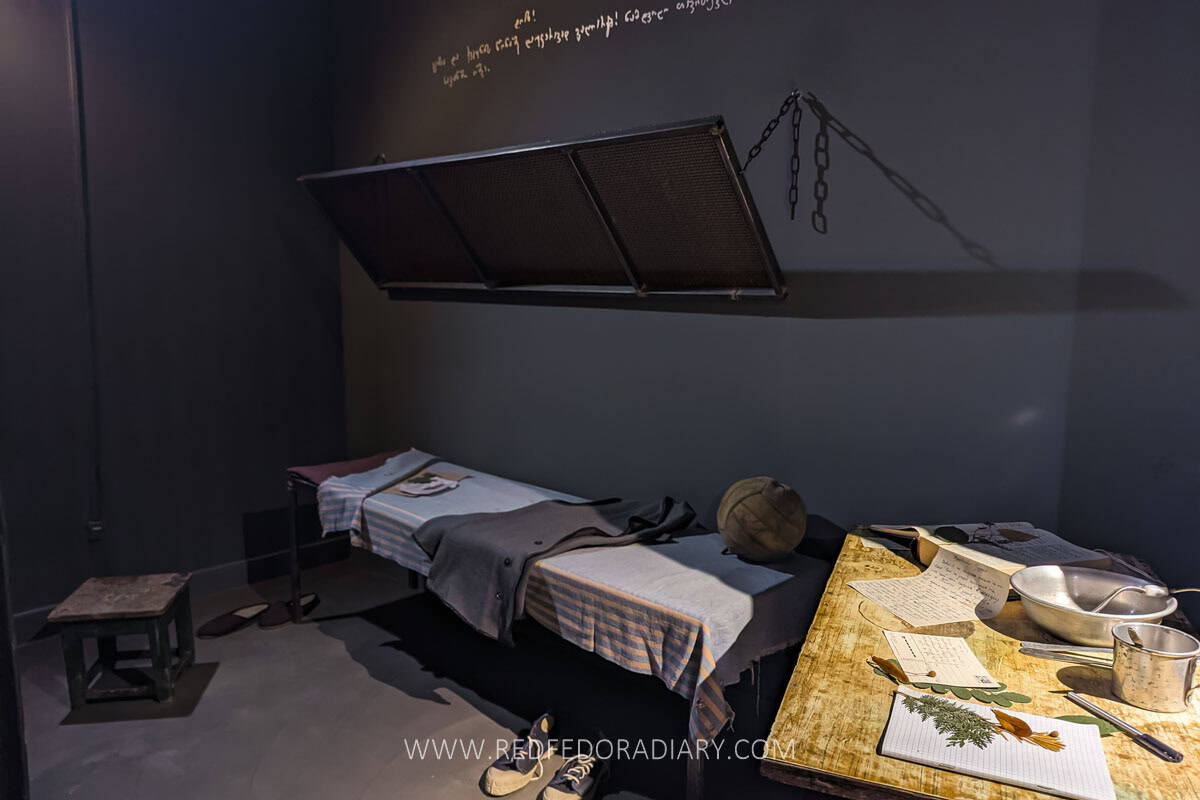
The basement level is especially striking — recreated as a prison cell to reflect the 10 years he spent in Soviet prisons across Russia and Georgia. This space displays his letters, telegrams, personal items, and documents from his imprisonment.
The upper floors explore his intellectual work and wide-ranging talents as a pianist, philosopher, translator, and writer. From essays and manuscripts to music records and personal belongings, you get a clear sense of his creative world.

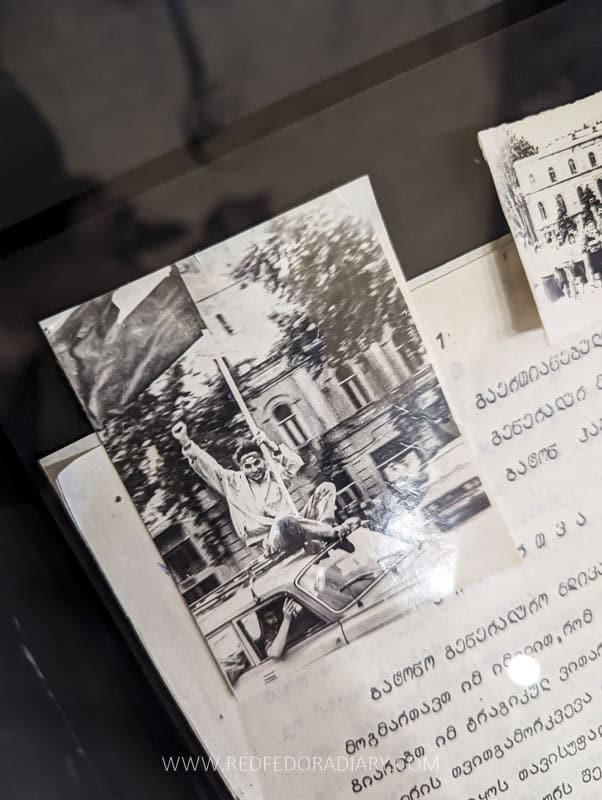
The final floor focuses on the National Liberation Movement and his death in 1989, with footage from pro-independence rallies and an emotional wall filled with condolence telegrams sent from all over Georgia.
If you want a deeper understanding of Georgia’s modern history, I highly recommend taking the guided tour — it adds valuable context to both Kostava’s legacy and the era’s struggle for independence.
- Opening hours: Tue-Sun from 10 am to 6 pm; Closed on Mondays
- Entrance fee: adults – 10 GEL for all nationalities
Best Tbilisi Tours & Day Trips – Handpicked by Local
Kote and Soso Tsereteli Memorial House-Museum
The Kote and Soso Tsereteli Memorial House-Museum is a powerful look into two figures who shaped Georgia’s modern history — one through scholarship, the other through art and rebellion.

The museum is located on Uznadze Street, in the apartment where the Tsereteli family lived for decades, and it preserves the atmosphere of the 1980s along with the emotional weight of that period.
Kote Tsereteli was one of Georgia’s most respected Orientalists and the founder of Hebrew and Aramaic studies in the country. His research in Aramaic dialectology influenced global scholarship, and his academic work shaped Georgians’ understanding of the linguistic and cultural connections between Georgia and the East.


One half of the apartment is devoted to his life, personal library, manuscripts, and documents from his scientific career.
The other half focuses on his son, Soso Tsereteli, an artist whose name is often associated with the tragic airplane hijacking attempt of 1983 — an event that later inspired Dato Turashvili’s book Flight from the USSR.
His former room still displays his original wall painting, his art materials, and a desk scribbled with the names of rock bands he listened to at the time.


A striking map on the wall shows the territory of the USSR in red, surrounded by archival photos, personal letters, and documents related to the hijacking case.
This is one of those museums where a guided tour truly elevates the experience. For an additional 20 GEL, the staff — incredibly knowledgeable and passionate — walks you through the stories of both father and son, adding context, personal details, and even perspectives on the hijacking case that you rarely hear elsewhere.
- Opening hours: Tue-Fri from 10 am to 6 pm. Closed on Mondays
- Entrance fee: adults – 5 GEL for all nationalities
Tbilisi Wine Museum
The Tbilisi Wine Museum is one of the most interesting places to visit in Tbilisi if you want to understand Georgia’s 8,000-year winemaking tradition.
Set in the former river entrance of the old caravanserai, this underground space displays ethnographic and archaeological items connected to Georgian wine culture.

You’ll see qvevri clay vessels, satsnakheli wine presses, drinking bowls, and tools once used to stir or clean qvevri, along with a bottle of one of the earliest locally produced wines.
Most objects here are replicas of originals held at the Georgian National Museum or the Vani Archaeological Museum-Reserve, but the guided tour (included in your ticket) still gives an excellent overview of UNESCO-listed qvevri winemaking customs.

The walls are lined with archival photos of old Tbilisi, turning the visit into a fun little challenge — try guessing the landmark or street before checking the caption.
There’s also an optional on-site wine tasting, and the museum is connected to Archive, a restaurant serving Georgian dishes in a cozy, atmospheric setting.
- Opening hours: Tue-Sun from 11 pm to 8 pm; Mondays from 12 pm to 6 pm.
- Entrance fee: adults – 10 GEL for Georgian citizens; 15 for foreigners
Tea Museum shop
Tucked away a few steps from Freedom/Liberty Square, the Bitadze Tea Museum Shop is one of my favorite unofficial museums for anyone curious about Georgian tea and its long, often overlooked history.
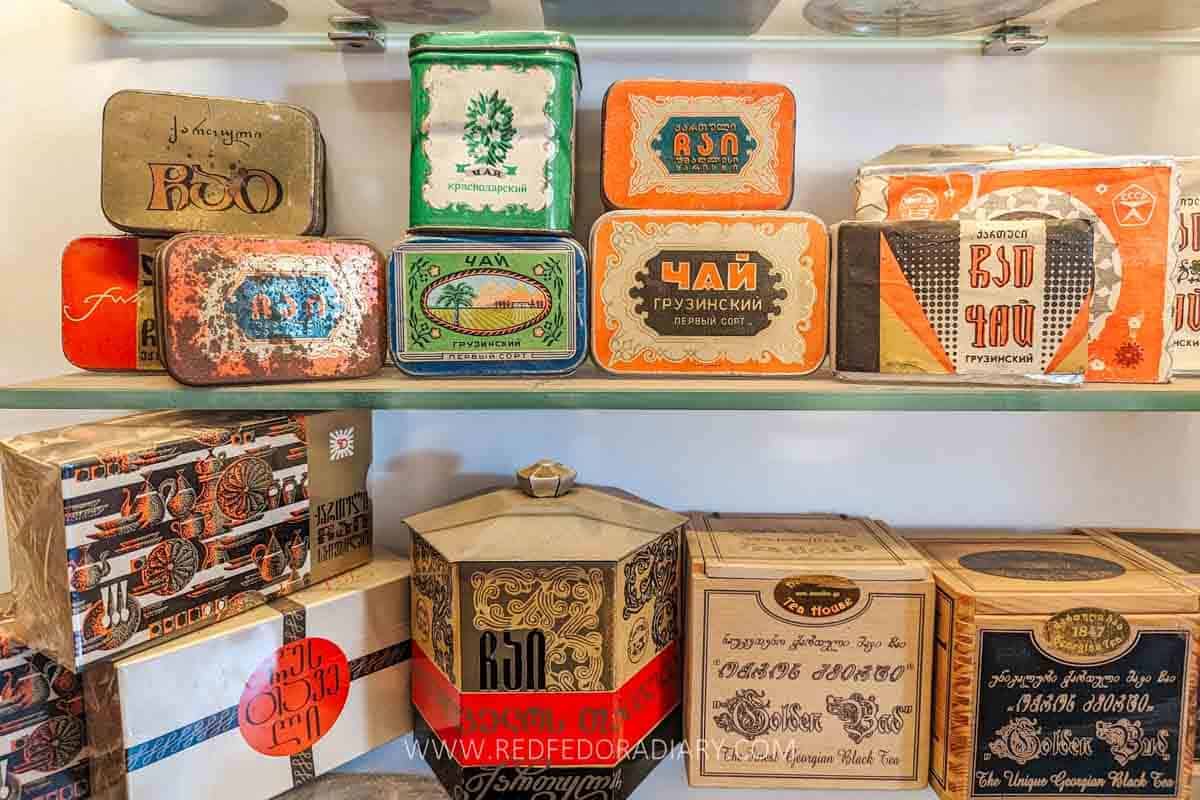
It’s a great little stop if you’re looking for something different to add to your list of what to do in Tbilisi.
Founded by father–son duo Shota and George Bitadze, this tiny space walks you through the story of Georgian tea — from its beginnings in Imperial Russia in 1847 to its peak during Soviet times and the decline that followed the collapse of the USSR.
Inside, you’ll find vintage photos, tea boxes, and labels that make the experience feel like a small time capsule.

One of the most valuable items here is the original 100-year-old packaging of Georgian tea marked with the state emblems of the Russian Empire, Austro-Hungarian Empire, Persia, Norway, and Belgium — all former distribution regions. This very tea earned global recognition at the 1899 Paris World Expo, winning a gold medal.
The Bitadze family began reviving Georgian tea production in 2006 and eventually founded the Georgian Organic Tea Producers Association, which now includes around ten members. Thanks to their work, tea cultivation is gradually returning to regions like Guria, Samegrelo, and Imereti.

Alongside selling tea from the association’s producers, the museum also offers a tea-tasting experience where you can sample different varieties and learn about their flavors. And if you want to go deeper, they can arrange visits to tea plantations managed by their members.
- Opening hours: Mon-Sat – 11 am to 8 pm. Closed on Sundays
- Entrance fee: FREE. The tea-tasting ceremony is 40 GEL per person and lasts 1-1:30 hrs. Maximum group: 4-5 people.
Best Hotels in Tbilisi – Where to Stay
Not sure which area suits you best? 📍 Check out my Where to Stay in Tbilisi guide for the top neighborhoods and hotel picks by budget before booking. Here are my quick picks for the best places to stay right now.
State Silk Museum
After four years of extensive renovation, the State Silk Museum reopened in October 2024 in its original building next to Dinamo Stadium. If you love unusual museums or architecture, this is one of the must-see places in Tbilisi, both for its collection and the building itself.

Designed by Polish architect Aleksander Szymkiewicz, who also worked on several landmark buildings in the city, the museum was purpose-built in the late 19th century with display cases explicitly tailored for its collection. The structure blends Classicism, Gothic, and Islamic influences, which earned it cultural heritage status in 2006.
Founded in 1887, it’s one of the oldest silk museums in the world and offers a detailed look at sericulture, silkworm biology, and textile production.


The second floor houses the permanent exhibition, where most displays were preserved in their original form with Georgian and Russian labels. Larger explanatory panels along the walls and wooden display cases help visitors follow the narrative.
You’ll find a wide range of items here: silk cocoons from more than 20 countries, mulberry leaves, tools and technologies used in silkworm farming, textile samples, and beautifully designed vintage packages. The museum’s collection includes more than 18,000 cocoons representing around 5,000 species.

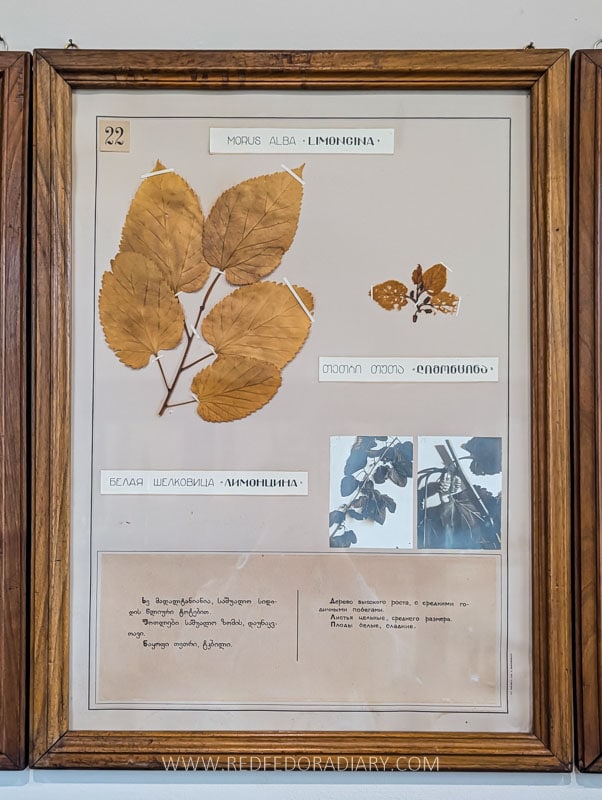
One of the most intriguing spaces is the red room, which features early 20th-century handmade infographics and Soviet-era posters illustrating how to care for silkworms and prevent diseases. There’s also a short Soviet video clip about silk production in Georgia that’s worth watching.
The third room on the upper floor is dedicated to a rare book library with publications in 17 languages dating back to the 18th and 19th centuries, including Chinese, Japanese, Persian, Hungarian, German, and French.
The ground floor hosts temporary exhibitions focused on sericulture, along with a short film about the silkworm lifecycle.
- Opening hours: Tue-Sat from 11 am to 6 pm; Closed on Mondays and Sundays
- Entrance fee: adults – 12 GEL for all nationalities; Guided service – an additional 40 GEL booked in advance, preferably two days before the visit. FREE every first Wednesday of the month.
The Ethnographic House by Porakishvili
Often called Porakishvili Hall, this building is one of Avlabari’s rare architectural survivors and a quiet must-see in Tbilisi for anyone who enjoys historic corners that haven’t been polished for tourism.

This partially preserved 17th-century house once belonged to the Porakishvili family and is the only known Darbazuli-style structure still standing in the city — a style typically associated with Samtskhe–Javakheti.
It offers a rare look at how homes in old Tbilisi once appeared before modern development and repeated invasions reshaped the city.

Most Shirvan-style houses that once filled this area were destroyed, especially during the invasion of Agha-Mahmud-Khan, yet this one survived.
Inside, a sketch by German architect Carl Zaar reveals its original design: a 12-sided crown, high gables, and elegant wall niches. Although renovations in 1904 nearly altered its layout entirely, many of its key details remain.


One of the most unexpected features is the small auditorium and stage — possibly added later, but intriguing nonetheless. There’s no signage or guide on-site, so visiting feels like piecing together a fragment of history on your own.
- Opening hours: Mon-Fri from 11 am to 6 pm; Closed on weekends
- Entrance fee: 3 GEL for all nationalities, paid in cash or card at the Kopala Hotel reception in front.
David Baazov Museum of History of Jews of Georgia
The David Baazov Museum of History of the Jews of Georgia is the place to learn about the centuries-old coexistence of Georgians and Jews. This relationship has shaped both communities for more than 2,000 years.
Many people assume the building was once a synagogue (I did too), but I learned during a Jewish Storytelling Tour that this isn’t the case.

It’s a compact, one-room museum, but it’s filled with exhibits that offer a clear picture of Jewish life across Georgia’s different regions. Signage is available in both English and Georgian, so you can easily understand what’s on display.
Many items come from Jewish communities around the country — including gravestones from Mtskheta, donated family heirlooms, ceremonial objects, and everyday items.


One of my favorite parts was seeing paintings that depict Georgian-Jewish wedding rituals. Without the storytelling tour, I probably wouldn’t have fully understood their meaning, so if you’re particularly interested in the topic, a guided visit or outside context helps.
- Opening hours: daily from 11 am to 5 pm
- Entrance fee: adults – 10 GEL for all nationalities, paid in cash.
Art museums in Tbilisi
Art Museum of Georgia
Recently reopened in a new space accessed from Lado Gudiashvili Street, the Art Museum of Georgia, or Shalva Amiranashvili Museum of Fine Arts is one of the top things to do in Tbilisi if you’re interested in Georgian art.

The museum spans three floors and is divided into three main sections; therefore, plan for around 1:30–2 hours, especially if you enjoy scanning the QR codes for extra audio and text explanations.
Medieval Georgian Relief Sculpture
The ground-floor hall is striking with its dark walls, lighting, and dramatic layout. It displays facades and interiors of Christian churches through figurative reliefs and ornamental motifs.
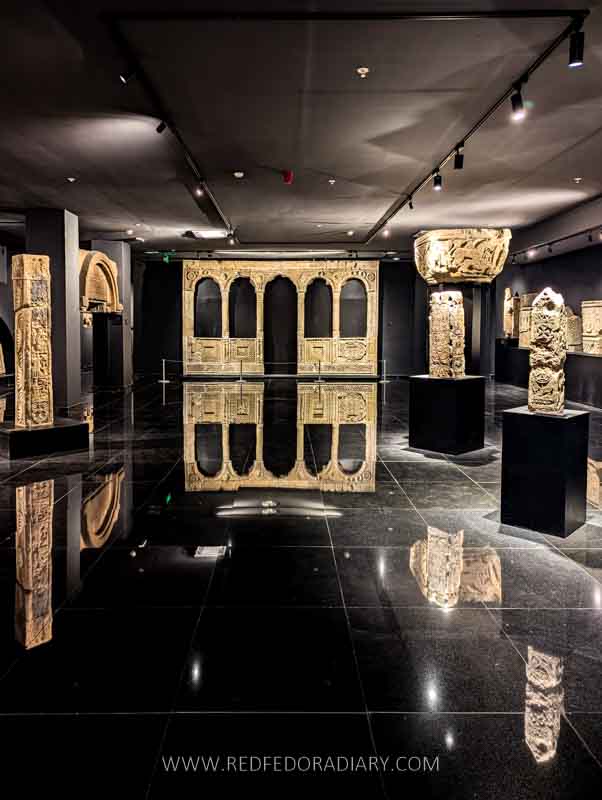

Since the Orthodox tradition avoids full sculpture, Georgia developed its own rich relief-carving style, as shown here in pieces dating from the 5th to the 12th centuries.
You’ll find masterpieces from Bolnisi Sioni, Ateni, Tserovani, Sapara, and Tsebelda (in Abkhazia). One highlight is the centrally placed altar of Satkhe Church from Kvemo Kartli, dating to 1171, featuring St. George and St. Theodore and an inscription in curvy Asomtavruli script.
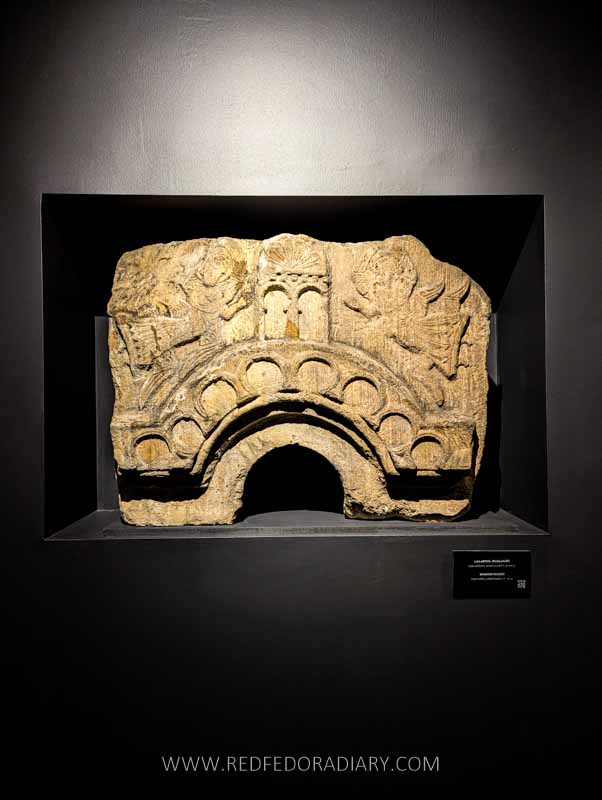

The altar fragments from Shiomghvime and the replica of the column top from Bagrati Cathedral are also remarkable.
Georgian Art from 1900 to 1930
The third-floor exhibition explores a vibrant period when Georgian artists blended European and Russian artistic movements with local themes and folklore. Many studied in St. Petersburg, Munich, Moscow, or Paris, and their influence is evident in their styles.

This is where you’ll see works by Niko Pirosmani, Lado Gudiashvili, and David Kakabadze, along with pieces by Elene Akhvlediani, Kirill Zdanevich, and Shalva Kikodze.
The panorama paintings by Pirosmani I hadn’t seen before were a highlight for me — especially his Rtveli (wine harvest) scenes. The Fisherman now hangs here instead of the National Gallery.


Kakabadze’s famous Imereti — My Mother, featured on the 10 GEL banknote, is displayed here as well.
The Paris and Luxembourg landscapes painted by Akhvlediani and Kikodze also offer a lovely glimpse into early 20th-century Europe from a Georgian perspective.
Paolo Veneziano to Wassily Kandinsky
The top floor reflects Dimitri Shevardnadze’s vision of creating a Georgian “Louvre” that connected local art with works from culturally related regions. Many of the paintings and sculptures were acquired through private collections, including those of Princess Elizabeth Orbeliani and the Romanov Palace in Likani, near Borjomi.


This hall brings together Western and Eastern European fine art from the early Renaissance to Modernism — landscapes, still lifes, religious scenes, and genre paintings by Paolo Veneziano, Guido Reni, Bernardo Daddi, Honoré Daumier, Auguste Rodin, and more.
The biggest surprise for me was seeing Lucas Cranach’s The Procuress (The Inappropriate Couple) — something I didn’t expect to find in Tbilisi at all.
- Opening hours: daily from 10 am to 6 pm. Closed on Mondays
- Entrance fee: adults – 15 GEL for Georgian citizens; 40 GEL for foreigners. International students and pupils – 20 GEL.
The National Gallery
Art enthusiasts will enjoy exploring the National Gallery on Rustaveli Avenue, just a short walk from the Georgian National Museum. It showcases works by several prominent 20th-century Georgian artists, including David Kakabadze, Niko Pirosmani, Lado Gudiashvili, Elene Akhvlediani, and sculptor Niko Nikoladze.

Many visitors come specifically for Niko Pirosmani, the self-taught painter who gained recognition only after his death. His naïve style captured rural life, everyday scenes, and the people of his time — shopkeepers, workers, merchants, and occasional noble groups.
He is also Georgia’s only true animalist painter, often depicting farm animals with a distinctive simplicity. His tiny house museum is also open to visitors (details below).

Some of Pirosmani’s most iconic pieces — like The Fisherman in a red shirt (now moved to the Art Museum of Georgia) and Margarita, the French actress he admired — have become so widely reproduced on Georgian souvenirs that seeing them in person can feel both familiar and tiring.
His legacy also inspired the Niko Movement, an urban art project in Georgia that brings together local and international street artists to create beautiful murals in Tbilisi and nationwide.
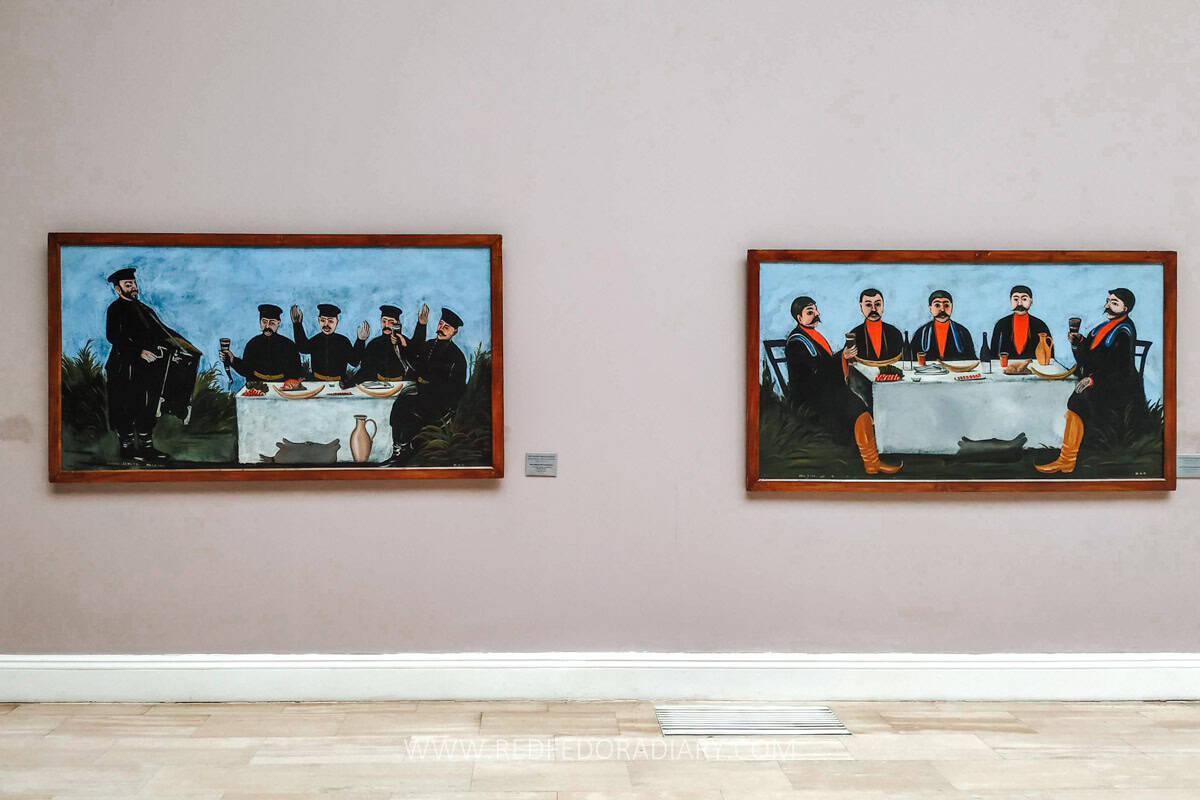
David Kakabadze, an avant-garde painter and art scholar, is another highlight. His work blends European modernist influences with Georgian traditions. His Imereti landscapes are especially beloved, and his groundbreaking experiments in cinematography make him one of Georgia’s most innovative artists.
Elene Akhvlediani’s colorful urban landscapes are among my favorite works of art from the 20th century, capturing the traditional Tbilisi courtyards and their carved wooden balconies. I include her house-museum as a separate listing below.
- Opening hours: Tue-Sun from 10 am to 6 pm. Closed on Mondays
- Entrance fee: adults – 13 GEL for Georgian citizens; 25 GEL for foreigners. International students and pupils – 10 GEL.
Art Palace
The Georgian State Museum of Theatre, Music, Cinema, and Choreography — better known as Art Palace — holds one of the most impressive collections of cultural heritage in the country.
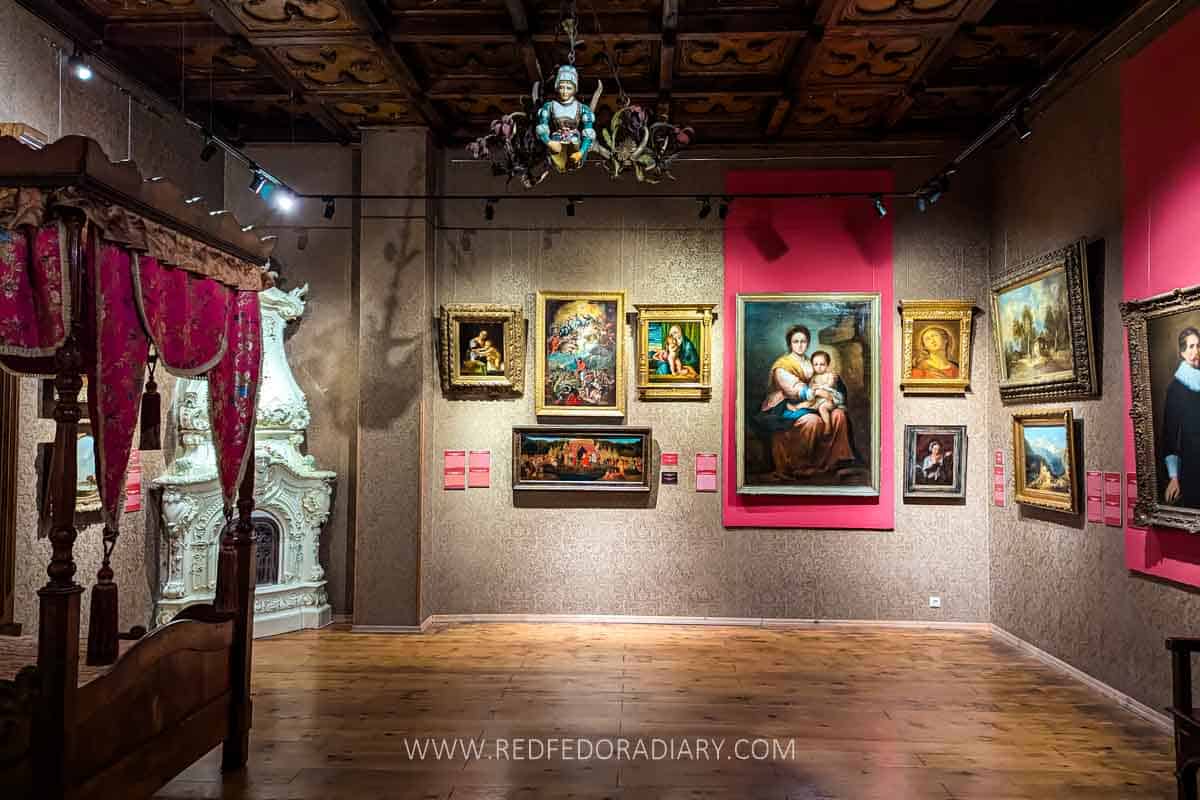
The building itself is a masterpiece designed by architect Paul Stern, blending Islamic and Gothic elements into one striking facade. Thanks to its romantic backstory, it’s also one of the more charming museums in Tbilisi for couples who enjoy places with a bit of history and drama.
In 1882, German Prince Constantine Oldenburg fell in love with Agraphina Japaridze, the wife of Georgian nobleman Dadiani of Samegrelo, after meeting her in Kutaisi. Despite the circumstances, the Prince confessed his feelings, and the two eventually settled in Tbilisi.


He commissioned this palace as a grand gesture of admiration — a gift that still stands as one of the city’s most beautiful buildings.
With more than 300,000 items in its collection, Art Palace is the only museum of its kind in the Caucasus, dedicated to the development of Georgian theater, cinema, ballet, folk music, opera, and even circus arts. Exhibitions also give a glimpse into the lifestyle of the aristocracy during that era.


If you’re curious about the creative side of Georgian history, this museum is a must. Manuscripts from writers and poets, film scripts, costume designs, posters, gramophone records, and stage outfits reveal how the arts evolved over generations.
In addition to Georgian collections, the museum also features Persian miniatures, French engravings, and old Tbilisi paintings, adding another layer to its already diverse exhibits.
- Opening hours: Tue-Sun from 10:30 am to 5:30 pm; Closed on Mondays
- Entrance fee: adults – 5 GEL for all nationalities
Tbilisi Art Academy Museum
Dating back to the 1850s, the Tbilisi Art Academy is housed in one of the city’s most architecturally fascinating buildings, blending European elements with Persian design.

Its so-called Mirror Halls — glittering rooms decorated by Qajar artists from Iran — make it one of the must-see places in Tbilisi that almost no one knows about.
As soon as you enter the museum area, a mirrored entryway with a fireplace covered floor to ceiling in mirror mosaics leads you into two larger halls.
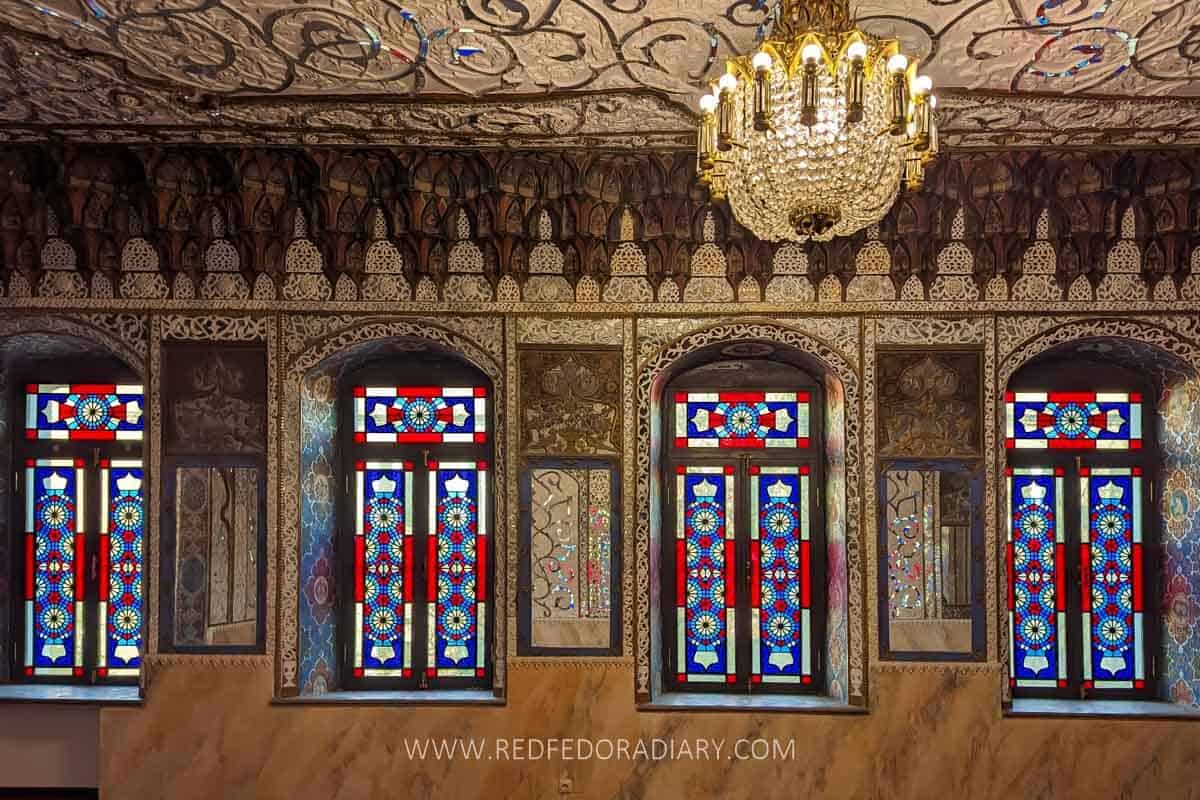
I include this as an optional stop on my Tbilisi Art Nouveau Walking Tour, and every time I bring guests here, they’re stunned — most say they wouldn’t have found it on their own, as very few blogs talk about this place.
The mirror technique used here is called āina-kāri — thousands of tiny glass pieces arranged to catch and reflect light in every direction. Some ceiling sections feature miniature paintings, sculpted details, and muqarnas, adding even more depth to the space.


Colorful stained-glass windows in mashrabiya patterns cast soft light into the rooms, bouncing beautifully off the mirrored walls.
How to find the museum
Finding the museum inside the academy can be confusing, as there are no signs. Enter through the gate near the garden, walk up two sets of stairs to the second floor, then turn left into a small hallway and look for a brown door on your right with an information board. If you get lost, someone from the academy will usually help point the way.
- Opening hours: Mon-Fri from 11 am to 5:30 pm; Closed on weekends
- Entrance fee: adults – 8 GEL for Georgian citizens; 12 GEL for foreigners
Georgian Museum of Fine Arts
The Georgian Museum of Fine Arts is one of the major museums in Tbilisi for modern art lovers.
Originally built to house the private collection of businessman Gia Jokhtaberidze, who later opened it to the public, the museum spans two large floors and showcases more than 3,500 works by over 100 Georgian artists, including paintings, sculptures, and modern furniture.
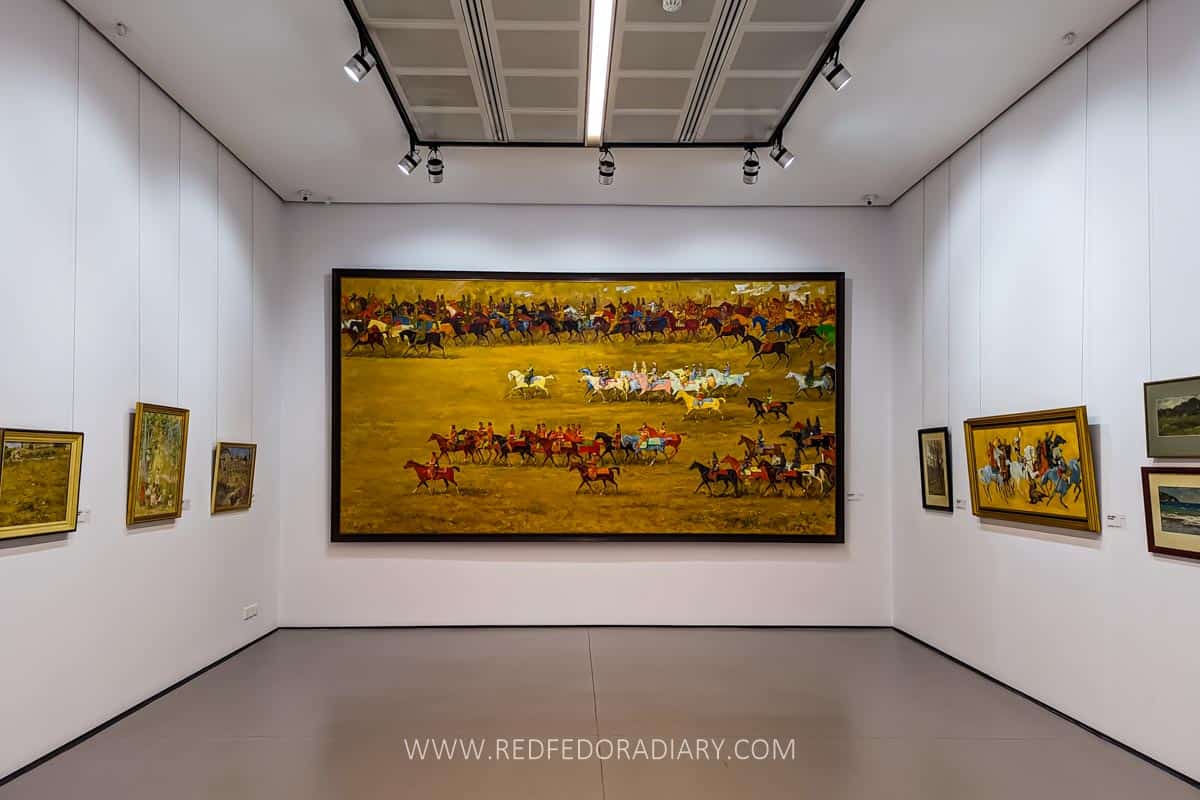
What I enjoyed the most during my visit was seeing multiple works by the same artist displayed in a single room — it gives you a clear sense of how their style, themes, and techniques evolved over time.
Each room includes a brief introduction to the artist, helping you understand their background before exploring their work. The museum is spacious and well organized, so plan for at least 1:30–2 hours to comfortably see everything.
- Opening hours: Tue-Sun from 10 am to 9 pm. Closed on Mondays
- Entrance fee: adults – 15 GEL for Georgian citizens and residents; 30 GEL for foreigners. FREE for children under 12 | More info
Elene Akhvlediani House Museum
Elene Akhvlediani is one of my favorite Georgian painters, and her house museum is one of those Tbilisi museums if you enjoy early 20th-century art and intimate creative spaces.
I’ve always loved her landscapes of Tbilisi, Sighnaghi, Telavi, Paris, Prague, and other cities — each one full of warmth and character.


Akhvlediani was a modernist painter, graphic artist, and stage designer. She studied at the Tbilisi Art Academy before moving to Paris, traveling through Italy along the way.
Her Parisian Views series captures the city as it looked in the early 20th century, while her later works focus heavily on Georgian urban landscapes, especially Telavi, Kutaisi, and Tbilisi, after returning home.
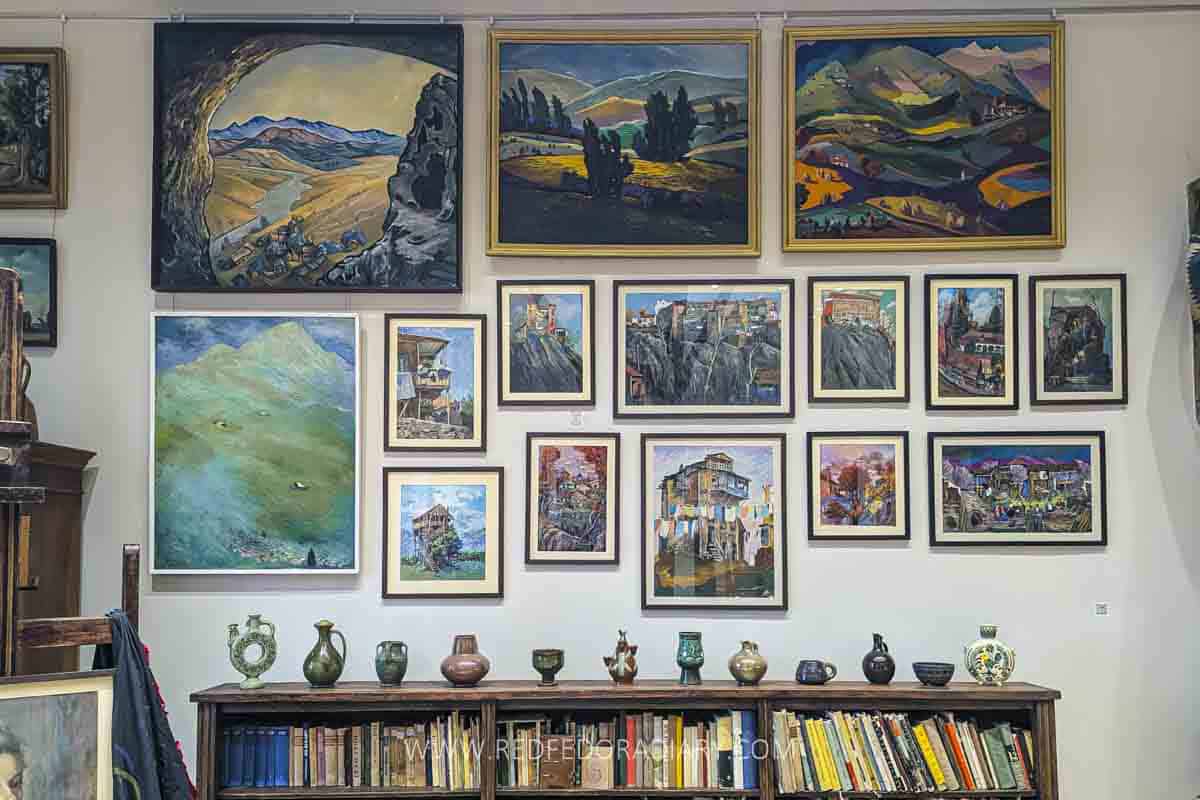
Her house museum displays a beautiful mix of graphic works, oil paintings, theatrical sketches, caricatures, personal archives, photographs from her time in Paris, and even her workstations.
She frequently hosted exhibitions and creative evenings here, turning her home into a gathering place for writers, artists, and musicians of her era.

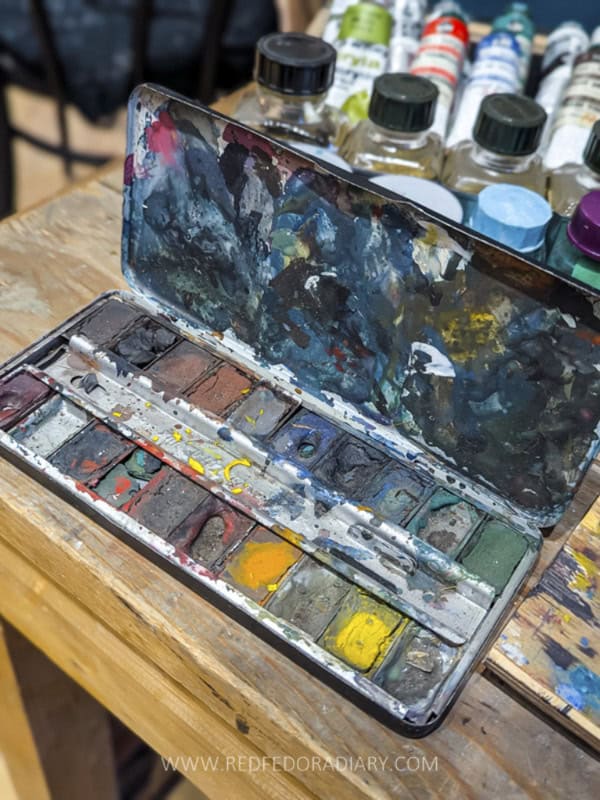
There is no signage next to the artworks, but printed information and QR codes accompany each group of paintings so you can learn more about the techniques and materials she used.
- Opening hours: Tue-Sun from 10 am to 6 pm. Closed on Mondays
- Entrance fee: adults – 5 GEL for Georgian citizens; 15 GEL for foreigners.
Niko Pirosmani House Museum
Temporarily closed due to renovation next door
Niko Pirosmanashvili — better known as Nikala or Niko Pirosmani — was born in 1862 in Mirzaani village in Kakheti. He only received global recognition after his death in 1918, yet today his works hang in major museums around the world alongside artists like Claude Monet, Pablo Picasso, and Edvard Munch.

A self-taught painter, Pirosmani opened a workshop in Tbilisi in 1880 with another self-taught artist, Zaziashvili. Together, they painted signboards for shops and businesses, and Pirosmani also decorated the walls of taverns — known as duqani — while working various jobs on the side, including as a tram conductor.
Despite his talent, he lived in poverty for most of his life, often accepting food or supplies in exchange for his work.
His tiny house museum in Tbilisi is the place where he spent the final years of his life, living in a small room under the stairs.
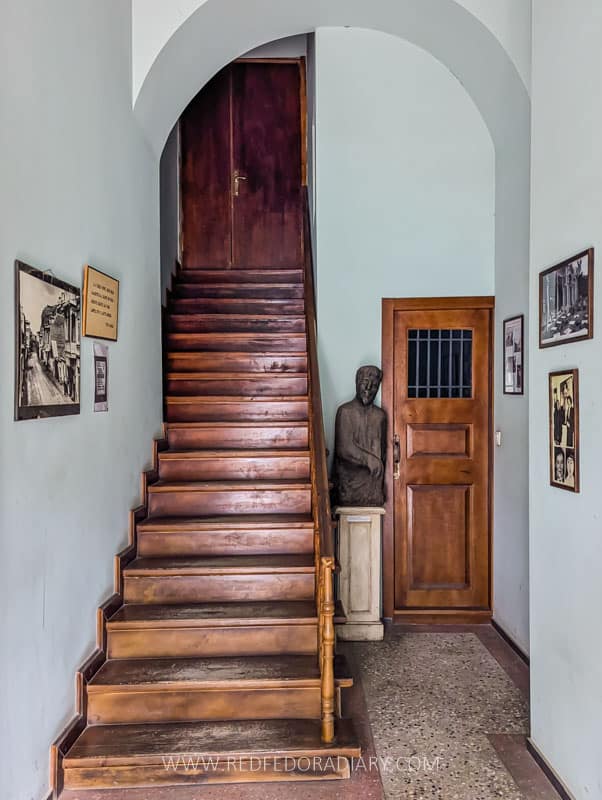

The museum consists of two small rooms: a compact exhibition hall showing portraits of Pirosmani painted by other artists and a short film about his life, and his living space, which contains only one original object — a carpet woven by his mother.
There is also a house museum in Mirzaani, but it’s currently closed for renovation.
Pirosmani’s work was rediscovered by Georgian-Polish artist Ilya Zdanevich, who introduced his pieces to Pablo Picasso. Picasso was so impressed that he drew a portrait of Pirosmani — now displayed in the Sighnaghi History Museum.
Lado Gudiashvili Exhibition Hall
Lado Gudiashvili is one of the most influential Georgian painters of the 20th century, and his small exhibition hall is an excellent addition to your Tbilisi sightseeing list.

He studied in Paris from 1919 to 1926 and was briefly part of Tsisperkantslebi — “The Blue Horns,” a group of Georgian symbolist poets. He also helped decorate the ground floor of Rustaveli Theater when it served as both a gathering place for the group and the famous café Kimerioni.
During his years in Paris, Gudiashvili spent time at La Ruche, the artist residency known for its creative community. There, he met notable figures such as Amedeo Modigliani, Mikhail Larionov, Ignacio Zuloaga, Natalia Goncharova, and even Pablo Picasso.

While some of his works can be viewed at the National Gallery, this exhibition hall focuses on two key periods: the 1940s–1950s and the 1960s–1970s.
His graphic pieces from the earlier period reflect a satirical protest against the moral and emotional destruction he witnessed in Soviet Georgia. These works often express his personal sorrow over the loss of sincerity and freedom within society.
The second floor highlights artworks inspired by Georgian frescoes, miniatures, and mosaics — a beautiful blend of local heritage and his own distinct style.
- Opening hours: Tue-Sun from 12 pm to 8 pm. Closed on Mondays
- Entrance fee: adults – 15 GEL for all nationalities | More info
Museums for literature & book lovers
Writers House of Georgia
Writers House of Georgia is not only one of my favorite buildings in the Sololaki neighborhood, but also my favorite mansion museum to get a real sense of how the bourgeoisie lived at the beginning of the 20th century.


The house once belonged to David Sarajishvili, a chemist, philanthropist, and businessman who brought the cognac-making technique to the Caucasus after studying in France. His name still appears on Georgian brandy bottles today.
Deeply connected to Georgian literature and friends with many writers of his era, Sarajishvili devoted the building to them in his will.
Today, the property functions partly as a museum and partly as a boutique hotel, with the seasonal Litera restaurant set in its courtyard.


The building itself is a masterpiece of Art Nouveau architecture, with wood as its main decorative element. The ground-floor living and dining room has a magnificent ceiling, and the wooden staircase with a stained-glass window is one of the most beautiful corners of the house.
The second floor includes rooms dedicated to Sarajishvili’s life and memorabilia, as well as a newly created Museum of Repressed Writers, opened in 2023. This small but powerful exhibition honors Georgian writers who were censored, persecuted, or executed during the Soviet era, especially in 1937.

Archival photos — some censored with black paint — letters, poems, and digital info boards trace the story of repression, censorship, and the literary movements of the Georgian SSR, including the Tsisperqantselebi (The Blue Horns).
One room, believed to be Sarajishvili’s bedroom, has an ornate Oriental-style ceiling and displays his personal items, his wife’s beautifully preserved dress, and porcelain with his initials.

There’s also a short animated film about the events and gatherings he hosted here, which gives a charming glimpse into Tbilisi’s early 20th-century cultural life.
Before leaving, step into the courtyard and look closely at the terrace mosaic designed specifically for Sarajishvili by Villeroy & Boch. And if the Litera café is open, stop for a coffee — the atmosphere is wonderfully calm.


Finally, don’t miss the bathroom on the ground floor. It has one of the most distinctive details in the entire house: a green sink with a fish-shaped face. Once you enter the main hallway and walk up the stairs, turn right, continue a few steps, and you’ll find it on your left.
- Opening hours: Tue- Sun from 11 am to 5 pm. Closed on Mondays.
- Entrance fee: adults – 10 GEL for Georgian citizens; 15 GEL for foreigners
The Museum of Books
Temporarily closed due to renovation
The Museum of Books is an excellent stop for book lovers — and one of the rare, fascinating, and free museums in Tbilisi for anyone curious about Georgia’s literary heritage.

This small, one-room museum inside the National Parliamentary Library of Georgia displays a permanent collection of rare books published in the country since the 17th century.
The first item you see is the 1888 print of The Knight in the Panther’s Skin, Georgia’s most iconic medieval poem. From there, the exhibition moves through early printed works such as the Georgian–Italian dictionary of 1629, the 1670 Georgian grammar, and the first book ever printed in Georgia — the Book of Psalms from 1709.
You’ll also find religious publications such as the 1709 Gospel Book, the 1710 Kontakion, and several 18th-century works, including Wisdom of Kitai (1784) and The Book of the Great Lent (1793). More recent items include Soviet-era books and magazines in both Georgian and Russian.

The only downside is that most explanations are in Georgian, with limited English beyond the title, printing place, and date. Still, the museum is worth visiting for its beautifully painted ceilings in the vestibule and the staircase — a detail many people miss and one of the city’s quiet Instagrammable corners.
Note: The entrance is now through the library’s main doors, not through the gate under the large book-shaped sign outside.
Tbilisi museums for music, ballet & performing arts
Zakaria Paliashvili Memorial House-Museum
Zakaria Paliashvili is the founder of the Georgian national compositional school and one of the most important figures in the development of Georgian classical music.

He professionalized the musical scene of his time and shaped what later became the national operatic style. His operas Abesalom and Eteri and Daisi remain the cornerstone of Georgian musical heritage, while his third opera, Latavra, introduced a heroic-patriotic tone to the genre. As a side note, you can see Daisi performing in the Tbilisi State Opera and Ballet Theater even today.
Paliashvili also recorded and arranged more than 300 Georgian folk songs and worked extensively with Georgian chants, including the 22-chant Liturgy of St. John Chrysostom.
Many places across the country carry his name today — including the State Opera and Ballet Theater in Tbilisi and a street in Kutaisi, where you can also visit his childhood house museum.


This house museum is where Paliashvili lived and worked from 1915 until his death. It’s a small, intimate space with three rooms displaying his personal belongings, family portraits, archival photos, sketches of opera costumes, posters from early performances, and the recording device he used during his travels across Georgia to document folk songs.
English signage is unfortunately missing, and even the Georgian labels are partially faded. If you’re interested in Georgian opera or performing arts, I recommend taking a guided tour (an additional 20 GEL) or reading a little about Paliashvili’s work beforehand — it adds a lot of context to the visit.
- Opening hours: Tue-Fri from 10 am to 6 pm. Closed on Mondays
- Entrance fee: adults – 5 GEL for all nationalities
Vakhtang Chabukiani Memorial House-Museum
Vakhtang Chabukiani is one of the most important figures in Georgian performing arts — a dancer, choreographer, and teacher who redefined male ballet and founded the national Georgian ballet school.

By merging classical ballet with Georgian folk dance, he created a distinctive style that became Georgia’s signature on the world stage.
His role as Othello is legendary. The 1958 Moscow premiere at the Bolshoi Theater was considered a milestone of Georgian art, and even Maya Plisetskaya praised the performance, writing: “Chabukiani’s Othello is unmatched… full of simplicity, grace, and wisdom, infused with childlike sincerity.”


Chabukiani choreographed his first piece at 15 and later performed dozens of roles during his time at the Leningrad (now Saint Petersburg) Opera and Ballet Theater.
His performances at Carnegie Hall helped cement his international reputation. He also wrote and directed two ballet films, Masters of Georgian Ballet and Othello.
The memorial house on David Aghmashenebeli Avenue is where he lived from 1947 until his death. Today, it is a small museum preserving parts of his life and work.


His original bedroom is still intact. Only a couple of original furniture pieces remain, but the rest of the apartment has been reorganized to display his personal items, stage costumes, documents, photographs, and private archive.
There is no English signage, so if you’re interested in ballet or Chabukiani’s influence on Georgian culture, I recommend taking the guided visit (20 GEL).
- Opening hours: Tue-Fri from 10 am to 6 pm. Closed on Mondays
- Entrance fee: adults – 5 GEL for all nationalities
Unusual & niche Tbilisi museums
Stalin Underground Printing House
Most people don’t expect to find a secret underground printing press hidden in the middle of Avlabari, which makes this one of the most unusual spots for history lovers.

From 1903 to 1906, this ordinary-looking house operated as an illegal printing press run by Georgian Marxists — including a young Joseph Stalin.
Revolutionary materials were printed here in Georgian, Russian, and Armenian, then smuggled across the Caucasus and Europe to support early socialist movements.
The press was concealed beneath the house and accessed through a deep well that led to a narrow tunnel — a risky setup that operated for several years until a police raid shut it down in 1906. The original structure was destroyed soon after, but later reconstructed as a museum.

Today, the building is in a somewhat deteriorated state, but it’s still a fascinating place to visit if you enjoy niche history and offbeat museums. Read my detailed post explaining exactly how to find it, what to expect, and how tours work — it’s worth checking before you go.
- Opening hours: Mon-Fri from 10 am to 6 pm. Closed on weekends
- Entrance fee: FREE, but you can leave a donation if you’d want.
Museum for History of Georgian Medicine
I didn’t expect much before visiting this museum, but it turned out to be one of the most fascinating ones if you enjoy unusual themes and well-curated exhibitions.
Spread over two floors, it tells the story of medicine in Georgia from ancient times to the present day. Opened in 1963, it was the first museum of its kind in the Soviet Union.


The exhibition begins with the ancient Kingdom of Colchis and the figure of Medea, known in mythology for her potions, poisons, cosmetics, and sedatives made from local herbs. Her knowledge is often linked to the early foundations of medicinal practice worldwide.
The museum has excellent signage in both English and Georgian, and the rooms are thoughtfully arranged. You’ll find manuscripts and objects documenting Georgia’s healing mineral waters, endemic medicinal plants, ancient surgical techniques, and even tools connected to kisa scrubbing traditions at Tbilisi’s sulfur baths.

Several trephined skulls displayed on the first floor show evidence of advanced surgical practices dating back to the end of the 4th millennium BCE. Other items include ancient needles, bronze measuring cups for drugs and poisons, forceps, medicine vessels, bandages, and even prostheses made from dog bones.
One of my favorite sections highlights Georgian folk medicine in Khevsureti and Tusheti, documented during 40 expeditions in the late 19th century. It includes recipes, spells, traditional surgical instruments, and portraits of prominent healers from those regions. I also loved the reproduction of a pharmacy in Vardzia Cave Town.


The second floor covers the Renaissance to modern periods, featuring manuscripts, herbarium samples, a recreated doctor’s office, and a large pharmacy cabinet.
Two striking anatomical and brain moulages brought from France in 1919 stand at the center of the room. There are also archival photos of old pharmacies in Tbilisi and beautifully preserved pharmaceutical labels.
Although the museum is very informative on its own, I left wishing I had taken a guided tour for an additional 25 GEL — it would have added even more context to an already impressive visit.
- Opening hours: Tue-Sun from 11 am to 6 pm; Closed on Mondays
- Entrance fee: adults – 10 GEL for all nationalities | More info
Miniature Museum of Yota Royal Gallery
If you’re into quirky, unexpected attractions, this tiny basement museum near Freedom/Liberty Square is one of those places.
It holds an impressive collection of 40 mm figurines — starting with pieces first created in 1974 for Kinder Surprise. Over the years, Kinder released around 30 themed series before stopping production in 1994, and many of those figures are preserved here.

The museum showcases the personal collection of Gregory Robakidze and is considered one of the world’s largest public displays of these miniature Kinder figures.
Alongside the international sets, Gregory also creates Georgian soldier figurines himself. His collection includes kings such as Tamar, Parnavaz, Aieti, Parsman Qveli, Mirian III, Vakhtang Gorgasali, and David Aghmashenebeli, as well as Georgian public figures who shaped the Republic of Georgia.

To make the experience even more immersive, Gregory builds small maquettes to create scenes around the miniatures. He usually gives visitors a short tour, explaining how he began the collection and the stories behind different pieces.
Note: If the museum is closed, call the number on the door (+995 577 788 284). The owners live upstairs and will come open it for you within a few minutes.
- Opening hours: Tue-Sun from 11 am to 8 pm
- Entrance fee: adults – 5 GEL for all nationalities
FAQ: Know before you go to Tbilisi museums
How many museums are in Tbilisi?
Tbilisi has several dozen museums, though there’s no single official count because many are run independently.
Two major organizations manage a large portion of them. Georgian National Museum (GNM), which includes 12 museums, two research centers, and four house museums across Tbilisi and Georgia.
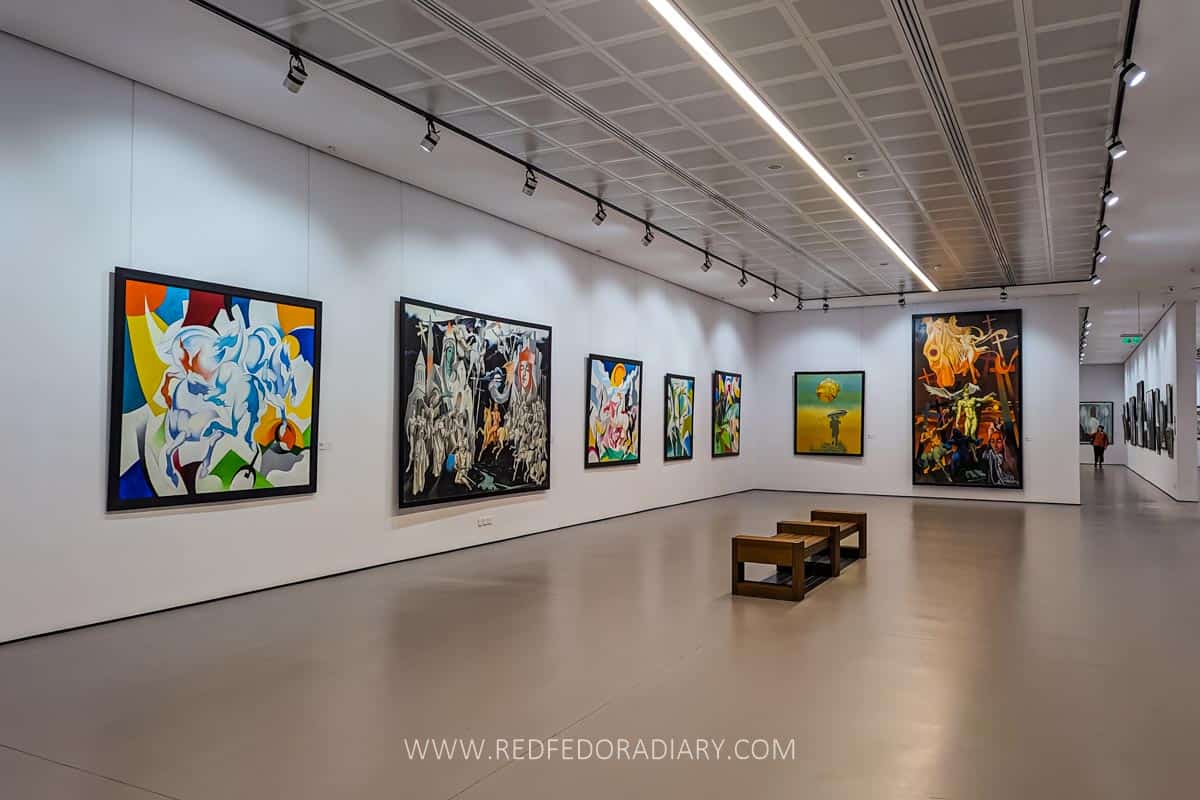
The Union of Museums, which brings together nine independent memorial museums of notable Georgian cultural figures.
Beyond these, the city has numerous small, private, and newly opened museums that aren’t part of either system.
Are museums open on Mondays?
Most museums in Tbilisi are closed on Mondays and national holidays. A few exceptions stay open, but it’s safest to plan museum visits from Tuesday to Sunday unless you check opening hours in advance.
How much do museums cost in Tbilisi?
Ticket prices vary widely depending on the museum, but here’s a general idea:
- Average price: from 5 GEL (for all nationalities) to 40 GEL (for foreigners).
- Georgian citizens usually receive lower rates at larger museums.
- Discounts are typical for students, school pupils, pensioners, disabled visitors, and socially vulnerable individuals with a valid card or documentation.
Children under 6 years old are free at most museums, and if you have a Georgian residence card, some museums may allow you to pay the Georgian rate — it’s always worth asking.

Can you pay by card at museums?
Most museums — big and small — accept card payments at the ticket desk. Only a few smaller or privately run museums are cash only, so it’s always a good idea to carry a bit of cash just in case.
Are there free museums in Tbilisi?
Very few. At the moment, the free museums are: Stalin’s Underground Printing House and the Museum of Books (temporarily closed for renovation).
Museums in Tbilisi typically do not offer free entrance days like many European cities. The only day when almost all museums are free is International Museum Day on May 18. The State Silk Museum occasionally offers free entry on specific days.

Which museums are best for rainy days?
All museums are good rainy-day options. The best ones for more extended indoor visits include Georgian National Museum, Art Museum of Georgia, National Gallery, and Georgian Museum of Fine Arts all four being within walking distances from each other).
You can also opt for Tbilisi History Museum + Wine Museum as they are in the same building, or take your time Art Palace. Small house museums also work well if you prefer short visits.
Do you need to book tickets in advance?
No. Museums in Tbilisi are rarely crowded, and you almost always buy your ticket at the door.
Are museums in Tbilisi family-friendly?
Yes — most museums are suitable for families. Larger venues like the Georgian National Museum and the Open Air Museum of Ethnography have plenty of space and displays for kids.
Smaller house museums are more compact but usually still fine for children.

Thanks for all the info. Just as a comment, I went to the National Gallery today. The cost is 25 lari and the Pirosmani paintings has changed from the picture you have posted. Which is very sad because there’s not anymore the fisherman, the giraffe, among others. I am so shocked they went from 5 to 25 the ticket price!!!
Hi Mario,
Thanks for letting me know. I am sorry that you had to pay 25, prices have increased drastically, and it was confirmed by the museum’s administration just now. I will also double-check the Pirosmani paintings because they have always been there.